#in their version the film was made in 1983
Text
asked my brother if he'd seen goncharov (1973) and he looked at me and grabbed this beanie that hes had for 2 years that ive seen but never read the tag on it and
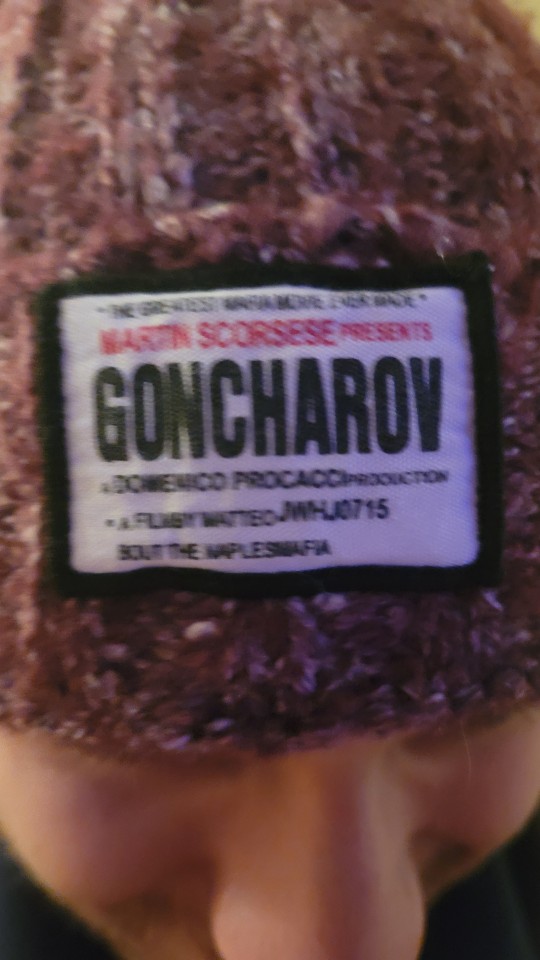
turns out he and his friends got matching beanies and made lore a full TWO YEARS ago
#in their version the film was made in 1983#my brother also has had a goncharov redeem on his twitch since this happened#im losing my mind#goncharov#unreality#he sprung up and ran around like a sleeper agent as soon as i said gonch
115K notes
·
View notes
Text
Here’s a Mega folder with a handful of junk for you trans girls to watch
https://mega.nz/folder/g14TWJaL#u5hER7DzOJbdJbAR0mhtBQ
///TGIRL FEATURE FILMS (alphabetical order)
Adam (2019) it's about a cis boy who's mistaken for a trans boy and rolls with it. Big cast of trans characters including a tgirl played by a tgirl who everyone wants to fuck. Directed by a trans dude. Highly legit. If you're still hung up on pre release speculation based on the novel then you're the most annoying person alive.
Assassination Nation (2018) The first half is Euphoria and the second half is The Purge. ONE OF THE BEST TGIRL MOVIES OF ALL TIME.
Bit (2019) Lesbian girl power vampire movie where the main character is a tgirl played by a tgirl. It's solid. I find it frustrating that they hint at her being trans without explicitly acknowledging it (and she's passing as fuck, so it's easy to not notice), but I know that's what some of y'all want.
Boy Meets Girl (2014) Cis dude for trans girl love story. Pretty normie, but also you see her fully naked (gock out) at the end.
Funeral Parade of Roses (1969) Extremely 60s. Cool as hell.
Lady Daddy (2010) South Korean romcom about a trans girl played by a cis girl who tries unconvincingly to back pass when she finds out she has a kid. Very cute.
Lingua Franca (2019) written directed and starring Isabel Sandoval. An undocumented trans woman immigrant in New York deals with a cis dude partner being a cis dude. Which is also the plot of The Garden Left Behind (2019).
Myra Breckinridge (1970) Raquel Welch is a trans woman and her goal is the destruction of the last vestigial traces of traditional manhood! It's Fight Club! It's Hackers! It's divisive, but it's probably my favorite movie!
So Pretty (2019) Literally the first scripted feature length (non pornographic tho it does have cock) film to feature two trans women played by trans women kissing eachother.
Something Must Break (2014) THE OTHER BEST TGIRL MOVIE OF ALL TIME. Drugs. Crimes. Gock. Slow motion pissing. Slow motion park Fucking. Genuinely the most beautiful sex scene I've seen in any movie. And she makes it to the end still alive and more sure of herself and at peace than ever.
Tangerine (2015) Groundbreaking and also a bunch of the secondary characters are real life pornstars (which I think is neat).
The Garden Left Behind (2019) This and Lingua Franca (2019) really are tgirl twin films, but (like with Antz and A Bug’s Life) the vibes and details make them distinct (I assume tho tbh I’ve never watched Antz).
///TGIRL DOCUMENTARIES
Bambi (2013) about a trans girl showgirl in 50s/60s paris
Paris is Burning (1990) basically it's Pose.
Shinjuku Boys (1995) Trans dudes working in a tokyo club that caters to tboy chasing cis girls. There's at least one trans girl in the mix too.
///FORCED FEMINIZATION
A Reflection of Fear (1972) They raised her as a girl and it made her do murders! It drags in places, but the girl in it is so ethereal and it has ageplay vibes and daddy issues.
Memory Run (1996) A very fun direct to video scifi action flick about fighting fascism by blowing up your pre transition self with a rocket launcher + it's based on a novel written by a trans woman.
She-Man A Story of Fixation (1967) Notable for being such a cliche sissy maid fantasy while also coming out so early + it was Bob Clark's first film lol.
Sleepaway Camp (1983) A more famous version of Reflection of Fear.
Surrender Dorothy (1998) A MUST WATCH. I personally bought a physical DVD and made an ISO of it for you because I was unsatisfied with the quality of the only copy that seemed to exist online. I ALSO PERSONALLY CREATED MY OWN SUBTITLES FOR IT BECAUSE EVEN THE DVD DIDN’T INCLUDE ANY! WHICH TOOK HOURS TO DO!
The Skin I Live In (2011) A rapist is kidnapped and turned into a girl by a mournful vengeful plastic surgeon. Which was also the plot of Victim (2010). I never really vibe with Pedro Almodóvar movies, but I recognize this is the preeminent forced feminization film.
///SHORT FILMS
Gender Troublemakers (1993) Some 90s Toronto trans girls fucking and discoursing. Explicit tgirl on tgirl action. This is the only one on the list that I haven’t actually watched yet. I’m hyped to watch it tho. Seems mindblowingly rad af.
Happy Birthday Marsha (2018) It's about Marsha P. Johnson.
I don't Know (1971) I'm obsessed with the trans girl in this one she just keeps popping up in all kinds of early 70s stuff. Directed by Penelope Spheeris (who is the sister of the cis gf in it).
Mesmeralda (2019) AN ABSOLUTE BANGER HOLY FUCK THE VIBES ARE OFF THE CHARTS! PLS WATCH THIS! I refuse to apologize for it being 15GB or to re encode it. It’s worth every byte and I want to ensure that this full quality copy doesn’t disappear off of the internet.
Pat Rocco's Changes (1970) It's that same girl again!
Queens at Heart (1967) I can't get over that hairdresser girl thinking she's back passing. Most adorably weak boymode ever.
Shangri-La (2021) Another Isabel Sandoval joint.
The Yellow Wallpaper (2021) Freshly post op girl with a supportive boyfriend goes unhinged.
Undress Me (2012) Jana Bringlöv Ekspong did a few short films. Give janabringlove a google after watching this.
///JUST LIKE BTW
Some of these would be tough to find elsewhere, but most of the movies are also watchable on fmovies and/or can be torrented in higher quality.
After you've worked your way through the folder then just start doing Google searches for trans films. Look at IMDB keywords and letterboxd lists. There are so many more out there. These are just like my personal picks.
6K notes
·
View notes
Text

FATHER & SON: James Earl Jones with his Father Robert Earl Jones on Stage in the 1962 Production "Moon on a Rainbow Shawl."
Robert Earl Jones (February 3, 1910 – September 7, 2006), sometimes credited as Earl Jones, was an American actor and professional boxer. One of the first prominent Black film stars, Jones was a living link with the Harlem Renaissance of the 1920s and 1930s, having worked with Langston Hughes early in his career.
Jones was best known for his leading roles in films such as Lying Lips (1939) and later in his career for supporting roles in films such as The Sting (1973), Trading Places (1983), The Cotton Club (1984), and Witness (1985).
Jones was born in northwestern Mississippi; the specific location is unclear as some sources indicate Senatobia, while others suggest nearby Coldwater. He left school at an early age to work as a sharecropper to help his family. He later became a prizefighter. Under the name "Battling Bill Stovall", he was a sparring partner of Joe Louis.
Jones became interested in theater after he moved to Chicago, as one of the thousands leaving the South in the Great Migration. He moved on to New York by the 1930s. He worked with young people in the Works Progress Administration, the largest New Deal agency, through which he met Langston Hughes, a young poet and playwright. Hughes cast him in his 1938 play, Don't You Want to Be Free?.
Jones also entered the film business, appearing in more than twenty films. His film career started with the leading role of a detective in the 1939 race film Lying Lips, written and directed by Oscar Micheaux, and Jones made his next screen appearance in Micheaux's The Notorious Elinor Lee (1940). Jones acted mostly in crime movies and dramas after that, with such highlights as Wild River (1960) and One Potato, Two Potato (1964). In the Oscar-winning 1973 film The Sting, he played Luther Coleman, an aging grifter whose con is requited with murder leading to the eponymous "sting". In the later 20th century, Jones appeared in several other noted films: Trading Places (1983) and Witness (1985).
Toward the end of his life, Jones was noted for his stage portrayal of Creon in The Gospel at Colonus (1988), a black musical version of the Oedipus legend. He also appeared in episodes of the long-running TV shows Lou Grant and Kojak. One of his last stage roles was in a 1991 Broadway production of Mule Bone by Hughes and Zora Neale Hurston, another important writer of the Harlem Renaissance. His last film was Rain Without Thunder (1993).
Although blacklisted by the House Un-American Activities Committee in the 1950s due to involvement with leftist groups, Jones was ultimately honored with a lifetime achievement award by the U.S. National Black Theatre Festival.
Jones was married three times. As a young man, he married Ruth Connolly (died 1986) in 1929; they had a son, James Earl Jones. Jones and Connolly separated before James was born in 1931, and the couple divorced in 1933. Jones did not come to know his son until the mid-1950s. He adopted a second son, Matthew Earl Jones. Jones died on September 7, 2006, in Englewood, New Jersey, from natural causes at age 96.
THEATRE
1945 The Hasty Heart (Blossom) Hudson Theatre, Broadway
1945 Strange Fruit (Henry) McIntosh NY theater production
1948 Volpone (Commendatori) City Center
1948 Set My People Free (Ned Bennett) Hudson Theatre, Broadway
1949 Caesar and Cleopatra (Nubian Slave) National Theatre, Broadway
1952 Fancy Meeting You Again (Second Nubian) Royale Theatre, Broadway
1956 Mister Johnson (Moma) Martin Beck Theater, Broadway
1962 Infidel Caesar (Soldier) Music Box Theater, Broadway
1962 The Moon Besieged (Shields Green) Lyceum Theatre, Broadway
1962 Moon on a Rainbow Shawl (Charlie Adams) East 11th Street Theatre, New York
1968 More Stately Mansions (Cato) Broadhurst Theatre, Broadway
1975 All God's Chillun Got Wings (Street Person) Circle in the Square Theatre, Broadway
1975 Death of a Salesman (Charley)
1977 Unexpected Guests (Man) Little Theatre, Broadway
1988 The Gospel at Colonus (Creon) Lunt-Fontanne Theatre, Broadway
1991 Mule Bone (Willie Lewis) Ethel Barrymore Theatre, Broadway
FILMS
1939 Lying Lips (Detective Wenzer )
1940 The Notorious Elinor Lee (Benny Blue)
1959 Odds Against Tomorrow (Club Employee uncredited)
1960 Wild River (Sam Johnson uncredited)
1960 The Secret of the Purple Reef (Tobias)
1964 Terror in the City (Farmer)
1964 One Potato, Two Potato (William Richards)
1968 Hang 'Em High
1971 Mississippi Summer (Performer)
1973 The Sting (Luther Coleman)
1974 Cockfighter (Buford)
1977 Proof of the Man (Wilshire Hayward )
1982 Cold River (The Trapper)
1983 Trading Places (Attendant)
1983 Sleepaway Camp (Ben)
1984 The Cotton Club (Stage Door Joe)
1984 Billions for Boris (Grandaddy)
1985 Witness (Custodian)
1988 Starlight: A Musical Movie (Joe)
1990 Maniac Cop 2 (Harry)
1993 Rain Without Thunder (Old Lawyer)
TELEVISION
1964 The Defenders (Joe Dean) Episode: The Brother Killers
1976 Kojak (Judge) Episode: Where to Go if you Have Nowhere to Go?
1977 The Displaced Person (Astor) Television movie
1978 Lou Grant (Earl Humphrey) Episode: Renewal
1979 Jennifer's Journey (Reuven )Television movie
1980 Oye Ollie (Performer) Television series
1981 The Sophisticated Gents (Big Ralph Joplin) 3 episodes
1982 One Life to Live
1985 Great Performances (Creon) Episode: The Gospel at Colonus
1990 True Blue (Performer) Episode: Blue Monday
#james earl jones#black tumblr#black literature#black community#black excellence#blackexcellence365#actor#robert earl jones#stage actor
194 notes
·
View notes
Text
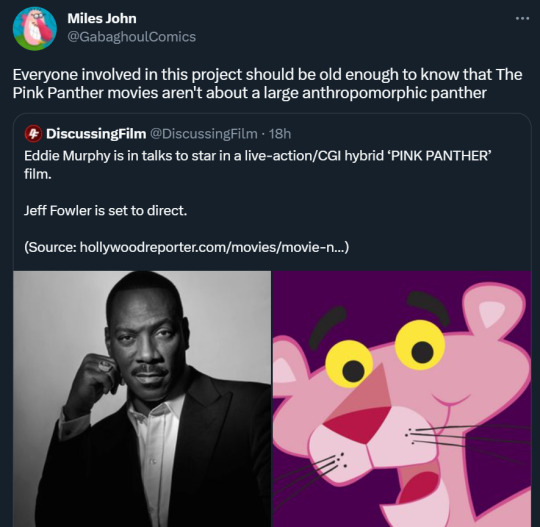
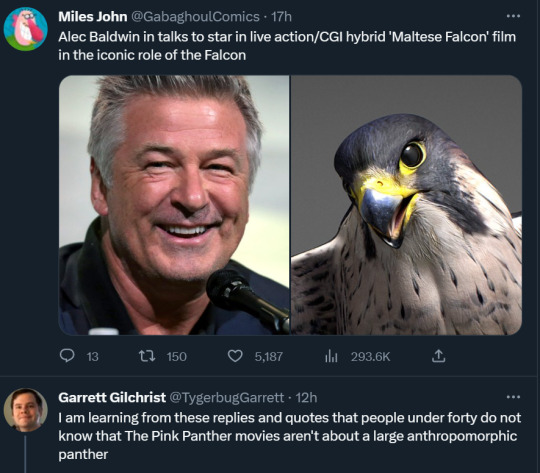
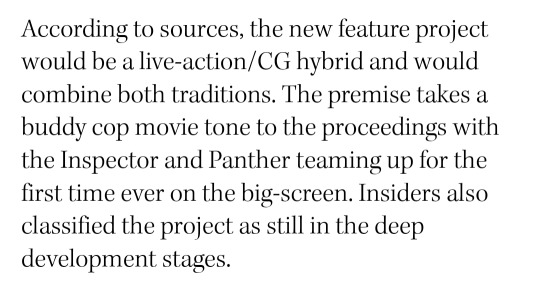

The 1963 film is a comedy about the theft of the Pink Panther diamond. It had an animated title sequence by Ken Harris for Friz Freleng. Both were Warner Bros/Looney Tunes animators. The Panther is more catlike here. Again he is a representation of a diamond used in the film's plot, which has a telltale flaw resembling a leaping panther.
Peter Sellers' character of the bumbling detective Inspector Clouseau proved popular, and returned in "A Shot In the Dark" (1964). Alan Arkin played a version of the character in 1968 which was less successful.
The animated Pink Panther character was refined further by Ken Harris and Richard Williams in "Return of the Pink Panther," in 1975, which established this as the title for the film series, and made the Panther "more elegant." Tony White animated the character for "The Pink Panther Strikes Again" (1976), for Richard Williams. Sellers returned again for Revenge of the Pink Panther (1978).
Friz Freleng (with David H. DePatie) did a series of animated shorts with the Pink Panther character in 1964 and 1965, after Warner Bros' animation studio had shut down in 1963. Warners tried to start the studio up again, but Freleng found the Pink Panther series more lucrative. These shorts were co-directed by Hawley Pratt who continued the series for MGM/UA. Other directors took over and the series continued until 1978, theatrically and on television.
Inspector Clouseau, and/or variations on him, are also in these cartoons as the "little man" who the Panther torments. There was also The Ant and the Aardvark (1969-1971).
The DePatie-Freleng studio was bought by Marvel comics around 1980. Marvel later produced series like Muppet Babies.
The name was occasionally brought back for TV series "Pink Panther and Sons" (1984-86), "The Pink Panther" (with Matt Frewer voicing the character, 1993-96), and "Pink Panther and Pals" (2010)
After Peter Sellers' death in 1980, there were many unsuccessful attempts to keep the Pink Panther live-action film series going, by Blake Edwards and producers. 1982's Trail of the Pink Panther briefly features a WWII-era Clouseau played by Danny Peacock, and unused footage of Sellers. Curse of the Pink Panther (1983) features Ted Wass. Son of the Pink Panther (1993) featured Roberto Benigni.
In 2006, Steve Martin starred as the bumbling Inspector Clouseau in a remake film of "The Pink Panther," with Kevin Kline and Beyonce Knowles. The film got a sequel in 2009. As is now customary, the films feature the Pink Panther diamond and have an animated title sequence with the animated Pink Panther character.
#the pink panther#this got a lot more reblogs before I added context#but I knew I had to add some context#if you don't add context you drive engagement because people want to say their piece about it
97 notes
·
View notes
Text
The Akatsuki’s Favorite Christmas Movies
Deidara and Hidan: Home Alone (1990)/Home Alone 2: Lost In New York (1992)
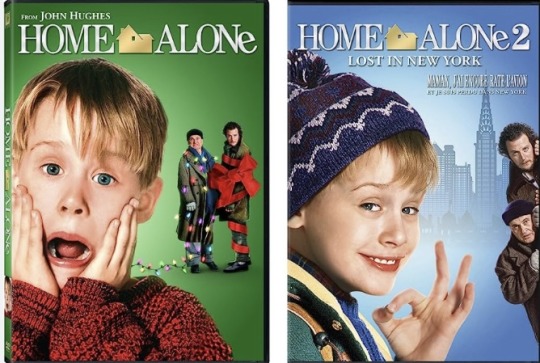
These two go crazy for these two classic movies. As they’re often shown on tv back to back, when they’re on, they will camp out in the living room with a plethora of snacks (and a couple of Plain Cheese pizzas, a la Kevin McCallister) and watch. Hidan is more so a fan of HA 1, while Deidara prefers its sequel. They tried to watch Home Alone 3 once but couldn’t even make it 30 minutes into the movie, it was so awful. While they watch, they like to talk about the tricks and traps that THEY would have set for the burglars, as well as various ways of “punishing” them for attacking their home (which, in Deidara and Hidan’s case, would be the hideout).
Itachi: The Nightmare Before Christmas (1993)

The dark fantasy-like world of this movie really appeals to Itachi, which is why it’s his favorite Christmas movie. He knows every single song in the movie word for word, and loves to sing along to them, changing his voice to match the character’s voice(s). He high-key relates to Jack Skellington and his feelings of discontent and wanting something new and different in his life. Managed exactly (1) time to get Kisame to dress up as Sally the rag doll and sing the romantic ending scene-song with him 🥺
Sasori: The Muppet Christmas Carol (1992)

A classic Christmas story, told with a cast that’s 90% made up of puppets. Is it any wonder why this is Sasori’s favorite holiday film? He watches not so much for the story itself, but he likes to study the movements of the puppets and how fluidly they imitate their human counterparts. His favorite scene is Kermit the Frog ice-skating with the rats on the frozen pond; he rewinds it over and over again. Interesting side note; he can’t watch this while Kakuzu is anywhere around, because Kakuzu absolutely despises this movie. If he walks into the room and it’s on he’s likely to throw his shoe at the tv. In his mind Ebenezer Scrooge was 100% correct in his miserly ways, and “Those damn ghosts should have minded their fucking business!” 😅
Kakuzu: Dr. Seuss’s How The Grinch Stole Christmas (2000)

The Grinch mirrors Kakuzu’s feelings towards the holidays perfectly. He’s seen the other versions of this movie, but really feels like Jim Carey brings the most life to the timeless green curmudgeon. He likes to stand up and put his hand on his chest (as if he’s reciting the pledge of allegiance) every single time the speech is given about how Christmas is nothing more than a cash-grab for greedy, spoiled people. He always cries at the end. Not because of the heartwarming ending, but because he’s upset that the Grinch “gave up” so easily.)
Tobi/Obito: Elf (2003) and A Christmas Story (1983)

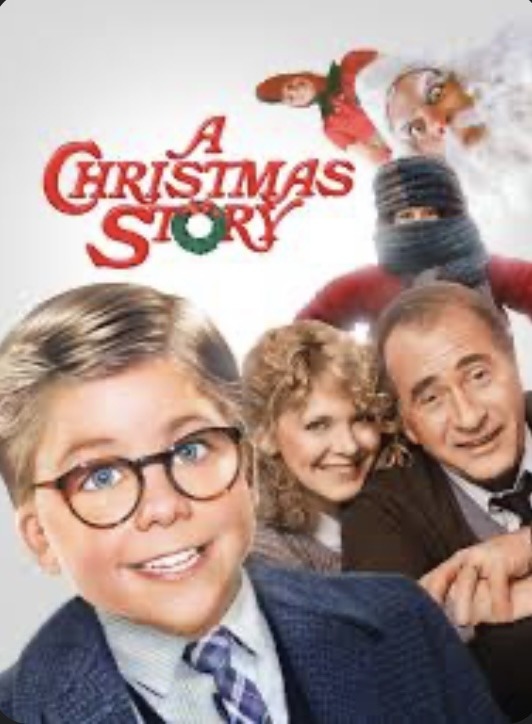
Will Ferrel gives a hilarious performance as a grown man who runs around acting like a very big child. So, naturally, Elf would be “Tobi’s” favorite movie. He likes to recreate the candy spaghetti that Buddy eats in the movie … which makes the others sick to their stomachs (and for Kakuzu to smack him upside the head for wasting good food). As Obito, his favorite Christmas movie is, surprisingly, A Christmas Story. He’s easily able to tap into the wonder and nostalgia of being a child that’s waiting for “the best time of the year for a kid”, and it reminds him of being a kid himself, before everything went to hell. He’ll sometimes watch with Itachi, and tease him about how much the main characters younger brother, Randy, reminds Obito of “the little brat I used to babysit” aka Itachi as a little kid.
Konan and Nagato: Die Hard (1988)
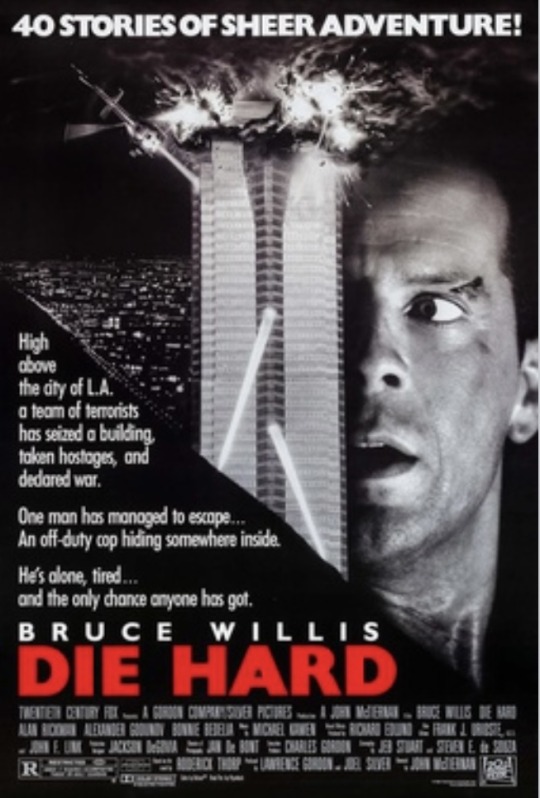
“Just because it happens on Christmas Eve doesn’t make it a Christmas movie!” Nagato and Konan have heard this more times than they could count, but the protests fall on deaf ears. Die Hard IS a Christmas movie, and it happens to be their favorite. Nagato is all about the action, and in fact, he’s used Bruce Willis’ strategizing as “training examples” for the rest of the Akatsuki. But for Konan, it’s all about the love story. A man willing to go to extreme lengths to protect the one he loves; that really resonates with the paper angel. The two of them usually cuddle throughout the movie, and start making out by the end, which the others tease them about.
Zetsu: Gremlins (1984)
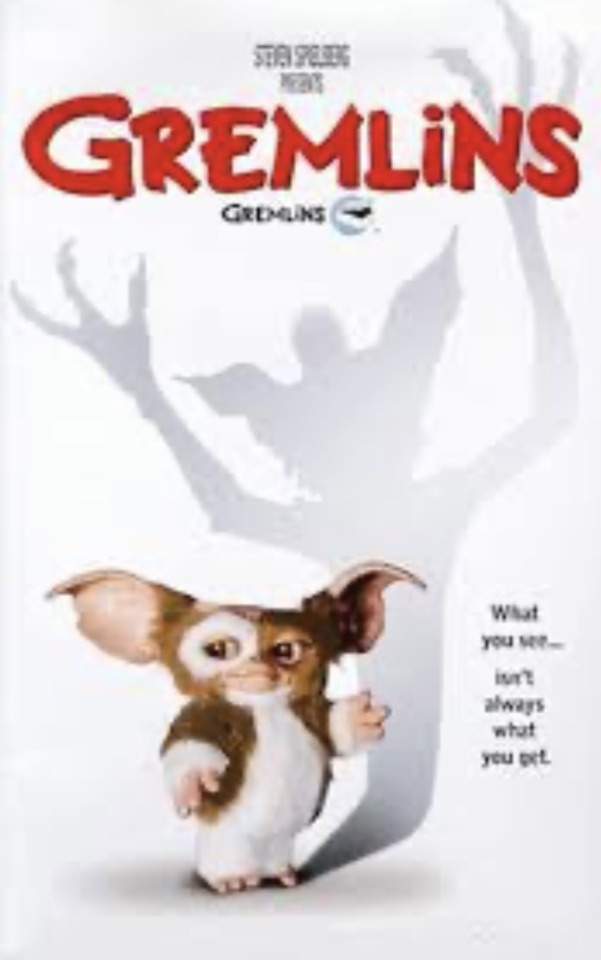
Another movie that could or could not be considered a Christmas movie, depending on who you’re asking. The concept of the Mogwai is very familiar to Zetsu: something that starts off as one thing, and replicates into seemingly endless (and terrifying) clones that wreak havoc on innocent people. The movie was ruined for him temporarily though; back when Orochimaru was still in the Akatsuki, they watched this movie together. Orochimaru got it into his mind that he could create a creature just as good, if not better, than Gizmo. What came out of that lab was a horrifying abomination of nature, and, like the movie, the creature got wet and rapidly multiplied into nightmarish shrieking demons that took the entire Akatsuki, together, to take down. Zetsu had nightmares for quite a while after this, and couldn’t even look at the box cover of this movie without breaking out in a cold sweat.
Kisame: The Santa Clause (1994)
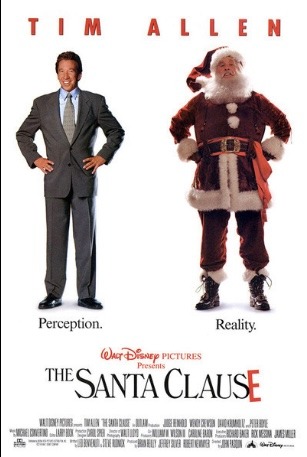
Kisame can’t really explain, even to himself, why he likes this particular movie so much. Actually, to him, this reads more as a horror: a man who committed an accidental murder and as punishment is slowly transformed into this magical, mythical character until he can barely recognize himself in the mirror? Scary as hell. But he likes the slow progression of Tim Allen’s character from denial to acceptance, and the implied freedom with letting go of your convictions and being who you were meant(?) to be. He enjoys watching this with Itachi; the scene where the elves send a team to break Santa out of jail always has the slim brunette laugh himself into tears, which Kisame just loves.
#the akatsuki#christmas movies#christmas#christmas 2023#implied kisaita#implied nagakona#nagato uzumaki#konan#itachi uchiha#obito uchiha#tobi#deidara#sasori#zetsu#kakuzu#hidan#kisame hoshigaki
42 notes
·
View notes
Text

Happy Posthumous Birthday Christopher John Reuel Tolkien (1924 - 2020), who is the third & youngest son of the author J.R.R. Tolkien (1892-1973), as well as the editor of much of his father's posthumously published work. He drew the original maps for his father's #TheLordOfTheRings books, which he signed as C.J.R.T.
From a child, Christopher Tolkien had long been part of the critical audience for his father's fiction, such as listening to his father’s tales of Bilbo Baggins, which were published as #TheHobbit. As a teenager and young adult, he offered a lot of feedback on “The Lord of the Rings” during its 15-year development. He also had the task of interpreting his father's sometimes self-contradictory maps of Middle-earth in order to produce the versions that were used in the books. He re-drew the main map in the late 1970’s to clarify the lettering and correct some errors and omissions.
J.R.R. Tolkien had written a large amount of material connected to the Middle-earth legendarium that was not published during his lifetime. He had originally intended to publish #TheSilmarillion along with “The Lord of the Rings”, and parts of it were in a finished state when he died in 1973; but the project was incomplete.
Once referring to his son Christopher as his "chief critic and collaborator", J.R.R. Tolkien had named Christopher his literary executor in his will. With this authority, Christopher organized the masses of his father's unpublished writings, some of which had been written on odd scraps of paper a half-century earlier. Much of the material was handwritten. Complicating matters, his father would sometimes write a newer draft over a half-erased first draft. Also, it was not uncommon for the names of characters routinely changing between the beginning and ending of the same draft.
Christopher worked on the manuscripts and was able to produce an edition of “The Silmarillion” for publication in 1977. His assistant for part of the work was Guy Gavriel Kay, who became a noted fantasy author himself.
“The Silmarillion” was followed by “Unfinished Tales” in 1980 and “The History of Middle-earth” in 12 volumes between 1983 and 1996. Most of the original source-texts have been made public from which “The Silmarillion” was constructed.
In April 2007, Christopher Tolkien published “The Children of Húrin”, whose story his father had brought to a relatively complete stage between 1951 and 1957 before abandoning it. This was one of J.R.R. Tolkien's earliest stories. Its first version dated back to 1918, and several versions were published in “The Silmarillion”, “Unfinished Tales”, and “The History of Middle-earth”.
“The Children of Húrin” is a synthesis of these and other sources. “Beren and Lúthien” is an editorial work and was published as a stand-alone book in 2017. The next year, “The Fall of Gondolin” was published also as an editorial work. “The Children of Húrin”, “Beren and Lúthien”, and “The Fall of Gondolin” make up the three "Great Tales" of the Elder Days, which J.R.R. Tolkien considered to be the biggest stories of the First Age.
Christopher served as chairman of the Tolkien Estate, Ltd., which was the entity formed to handle the business side of his father's literary legacy. He also served as a trustee of the Tolkien Charitable Trust until his retirement in 2018.
In 2001, Christopher expressed doubts over “The Lord of the Rings” film trilogy that was directed by Peter Jackson. He questioned the viability of a film interpretation that retained the essence of the work, but stressed that this was just his opinion. In 2008, he commenced legal proceedings against New Line Cinema, which he claimed owed his family £80 million in unpaid royalties. In September, 2009, he and New Line reached an undisclosed settlement. He also withdrew his legal objection to “The Hobbit” films. But, in a 2012 interview with “Le Monde”, he criticised the films saying, "They gutted the book, making an action film for 15 to 25-year-olds."
#jrr tolkien#silmarillion#the hobbit#the fall of gondolin#christopher tolkien#beren and luthien#children of hurin#lord of the rings#lotr#middle earth
22 notes
·
View notes
Text
youtube
"They Don't Know" is a song originally composed and recorded by Kirsty MacColl but made famous by Tracey Ullman when she came out with her own version in 1983. Ullman's single reached No. 2 in the UK and No. 8 in the US.
The music video featured Paul McCartney in a cameo (McCartney had just completed filming Give My Regards to Broad Street in which Ullman had a cameo). Directed by Stiff Records president Dave Robinson, the storyline was devised by Ullman herself in which she played a young woman in a blossoming romantic relationship with her working class, ne'er do well boyfriend in the 1960s. The video concludes with her as a dowdy council estate type mother (not unlike her character Betty Tomlinson from the comedy sketch show Three of a Kind), unkempt, heavily pregnant and shopping for groceries in her slippers, her life of domestic drudgery sustained only by her fantasy of being in a relationship with her idol Paul McCartney.
26 notes
·
View notes
Photo

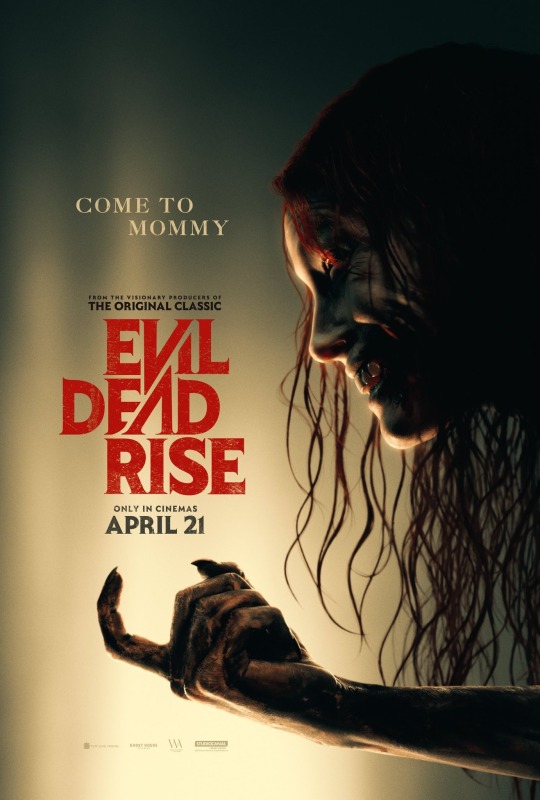
While most of The Evil Dead's 40th anniversary festivities took place two years ago, as it premiered on October 15, 1981 at at Detroit's Redford Theatre, the film didn't officially open theatrically until April 15, 1983.
A surprise success thanks in part to a rave review from Stephen King ("The most ferociously original horror film of the year" was plastered all over the marketing), the cult classic spawned a franchise: Evil Dead II in 1987, Army of Darkness in 1992, the Evil Dead reboot in 2013, and the Ash vs. Evil Dead series from 2015 to 2018, along with video games, comic books, a musical, and a myriad of merchandise.
As a serendipitous treat for fans, the latest installment in the beloved series is releasing almost exactly 40 years after the original. Following a much-buzzed-about premiere at South by Southwest last month, get your chainsaws ready for Evil Dead Rise to hit theaters on April 21 via Warner Bros.
Lee Cronin, who made an impressive feature debut with 2019's The Hole in the Ground, writes and directs. Lily Sullivan, Alyssa Sutherland, Morgan Davies, Gabrielle Echols, and Nell Fisher star. The Evil Dead creator Sam Raimi, star Bruce Campbell, and producer Rob Tapert serve as producers.
The Evil Dead franchise is unique in that each entry is tonally different, and fans' ranking of the installments are all over the place as a result. I'm eager to see where Evil Dead Rise lands on my personal list following the advance screening Broke Horror Fan is sponsoring in Boston next week.
Although I enjoy each installment for different reasons, my current ranking is as follows:
The Evil Dead
Evil Dead II
Ash vs. Evil Dead
Evil Dead 2003
Army of Darkness
youtube
Moving the action out of the woods and into the city, Evil Dead Rise tells a twisted tale of two estranged sisters, played by Sutherland and Sullivan, whose reunion is cut short by the rise of flesh-possessing demons, thrusting them into a primal battle for survival as they face the most nightmarish version of family imaginable.
#evil dead#evil dead rise#the evil dead#bruce campbell#sam raimi#horror#evil dead 2#army of darkness#ash vs evil dead#lee cronin#lily sullivan#alyssa sutherland#morgan davies#80s horror#1980s horror
107 notes
·
View notes
Text
Ernestine Wade

By Life Magazine via Google Images-Photographer Loomis Dean., Fair use, https://en.wikipedia.org/w/index.php?curid=28885998
Ernestine Wade (August 7, 1906 – April 15, 1983) was an American actress. She was best known for playing the role of Sapphire Stevens on both the radio and TV versions of The Amos 'n' Andy Show.
Born in Jackson, Mississippi, Wade was trained as a singer and organist. Her family had a strong connection to the theater. Her mother, Hazel Wade, worked in vaudeville as a performer, while her maternal grandmother, Mrs. Johnson, worked for the Lincoln Theater in Baltimore, Maryland.
Ernestine grew up in Los Angeles and started her acting career at age four. In 1935, Ernestine was a member of the Four Hot Chocolates singing group. She appeared in bit parts in films and did the voice performance of a butterfly in the 1946 Walt Disney production Song of the South. Wade was a member of the choir organized by actress-singer Anne Brown for the filming of the George Gershwin biographical film Rhapsody in Blue (1945) and appeared in the film as one of the "Catfish Row" residents in the Porgy and Bess segment. She enjoyed the highest level of prominence on Amos 'n Andy by playing the shrewish, demanding and manipulative wife of George "Kingfish" Stevens. Wade, Johnny Lee, and Lillian Randolph, Amanda Randolph, Jester Hairston, Roy Glenn (and several others) were among the Amos 'n' Andy radio cast members to also appear in the TV series.
Ernestine began playing Sapphire Stevens in 1939, but originally came to the Amos 'n' Andy radio show in the role of Valada Green, a lady who believed she had married Andy. In her interview that is part of the documentary Amos 'n' Andy: Anatomy of a Controversy, Wade related how she got the job with the radio show. Initially there for a singing role, she was asked if she could "do lines". When the answer was yes, she was first asked to say "I do" and then to scream; the scream got her the role of Valada Green. Ernestine also played the radio roles of The Widow Armbruster, Sara Fletcher, and Mrs. Van Porter.
In a 1979 interview, Ernestine related that she would often be stopped by strangers who recognized her from the television show, saying "I know who you are and I want to ask you, is that your real husband?" At her home, she had framed signed photos from the members of the Amos 'n' Andy television show cast. Tim Moore, her TV husband, wrote the following on his photo: "My Best Wishes to My Darling Battle Ax from the Kingfish Tim Moore".
Wade defended her character against criticism of being a negative stereotype of African American women. In a 1973 interview, she stated "I know there were those who were offended by it, but I still have people stop me on the street to tell me how much they enjoyed it. And many of those people are black members of the NAACP." The documentary Amos 'n' Andy: Anatomy of a Controversy covered the history of the radio and television shows as well as interviews with surviving cast members. Ernestine was among them, and she continued her defense of the show and those with roles in it. She believed that the roles she and her colleagues played made it possible for African-American actors who came later to be cast in a wider variety of roles. She also considered the early typecast roles, where women most often were cast as maids, not to be damaging, seeing them in the sense of someone being either given the role of the hero or the part of the villain.
In later years, she continued as an actress, doing more voice work for radio and cartoons. After Amos 'n' Andy, Wade did voice work in television and radio commercials. Ernestine also did office work and played the organ.
She also appeared in a 1967 episode of TV's Family Affair as a maid working for a stage actress played by Joan Blondell.
Ernestine Wade is buried in Angelus-Rosedale Cemetery in Los Angeles, California. Because she had no headstone, the West Adams Heritage Association marked her grave with a plaque
8 notes
·
View notes
Text

As we await to potentially hear some news on COYOTE VS. ACME - a film that might possibly be locked away forever because of executives being jackasses, let me share a piece of Disney history:
It's often written that THE RESCUERS DOWN UNDER, made at Walt Disney Feature Animation and released theatrically in 1990, was a victim of a squashed marketing campaign. The studio's first sequel, the story often goes: After the film opened with underwhelming numbers the same week as HOME ALONE, then-Chairman of the Disney film division Jeffrey Katzenberg pulled all the marketing for the film and thus left it to fade away into the Christmas season. It remained the sole disappointment of the "Disney Renaissance", sandwiched between hit films like OLIVER & COMPANY, THE LITTLE MERMAID, BEAUTY AND THE BEAST, ALADDIN, and THE LION KING.
Here are two corrections to that tale...
A) The marketing was not pulled immediately.
B) The film was deemed dead-on-arrival *well* before release.
So, a week or so after the film came out, Disney tried a "now playing" trailer that ran before other movies in auditoriums next door. It's proof that Disney didn't give up on the movie right away, and gave it one last push... But it just didn't do it, and the movie made less than half of what LITTLE MERMAID made a year earlier.
youtube
As for the film being written off (not as a tax write-off!), here's what happened.
In March 1989, Disney theatrically re-released the original THE RESCUERS that came out all the way back in 1977. This was the film's third ever theatrical release, the previous one being in 1983. A good chunk of the Disney animated classics did pretty robust business in re-issues, before they came to home video. BAMBI, for example, made over $30m in the summer of 1988, SNOW WHITE made over $46m in 1987.
The $21m gross that THE RESCUERS pulled in, in early 1989, was deemed a disappointment. THE RESCUERS DOWN UNDER was greenlit on the grounds of the original having earned the most money for a Disney animated film on its initial release. The rationale from executives after that must've been "Oh crap... We greenlit a sequel to this thing."
It was apparently too late to cancel, though, so they went through with it. If anything, it served as a good testing ground for that digital ink-and-paint software Disney Animation staff were toying with for a single shot in THE LITTLE MERMAID. A little thing called C.A.P.S. It also allowed more time on BEAUTY AND THE BEAST and ALADDIN.
THE RESCUERS DOWN UNDER went into production, but there wasn't much confidence in it before release. Even though they attached a new half-hour Mickey Mouse cartoon to it (THE PRINCE AND THE PAUPER), this was treated as a minor effort long before release. The execs were far more excited about BEAUTY AND THE BEAST, as by that point, the LITTLE MERMAID songwriting team - of course, Howard Ashman and Alan Menken - had been brought onto the movie after the previous version had been thrown right out.
So DOWN UNDER served as a stopgap, and its failing meant no more theatrical sequels (sans Roy E. Disney's pet project, FANTASIA 2000) and probably no more animated action-adventures like it. The string of movies released thereafter stuck very close to LITTLE MERMAID and BEAUTY AND THE BEAST's templates. But in the end, they got the C.A.P.S. system's success out of it, and an eventual home video hit.
Now, think about THE RESCUERS not doing great on that re-release... And DOWN UNDER's release date. March 1989, November 1990. Disney actually had plenty of time to throw that movie out, but they didn't... Whatever the reason, they didn't.
And here, today, we have David Zaslav - CEO of Warner Bros. Discovery - shelving near-complete or fully-completed movies for tax write-off purposes. Loser behavior. See the damn thing through, mate.
I could also relate the time Disney's movie division firmly determined that audiences had moved on from fairy tales, following the disappointing box office returns of THE PRINCESS AND THE FROG. In early 2010, it was made very clear that there would never be another fairy tale movie from the studio. Despite a history in making beloved fairy tale adaptations or fairy tale-like stories... Nope, it was all over. John Lasseter and Ed Catmull acting like the pallbearers, saying that Disney Animation wouldn't invest in any.
At the time, a SNOW QUEEN movie was put on ice, a JACK AND THE BEANSTALK tale had trouble taking off... but one movie was a little too far along to cancel... RAPUNZEL. And that picture had already gone through a few director changes and reinventions, which no doubt ballooned its budget over the course of three decades. There had been various goes at a Rapunzel story at Disney Animation in the late '90s and in the early-to-mid aughts, in addition to another version that was not quite approved of by Lasseter. Glen Keane, who was supposed to direct the film with Dean Wellins, stepped down. RAPUNZEL's journey to the screen was as long as her hair.
So in the final lap, in early 2010, the movie was re-titled from RAPUNZEL to TANGLED in a silly attempt to make it appeal to the audience that supposedly tanked THE PRINCESS AND THE FROG: 6-to-12 year old boys... Yeah, that was a real low point, wasn't it? Silly focus groups. I'll always get a kick out of the sketch that longtime Disney storyman/artist Floyd Norman whipped up for it in response:
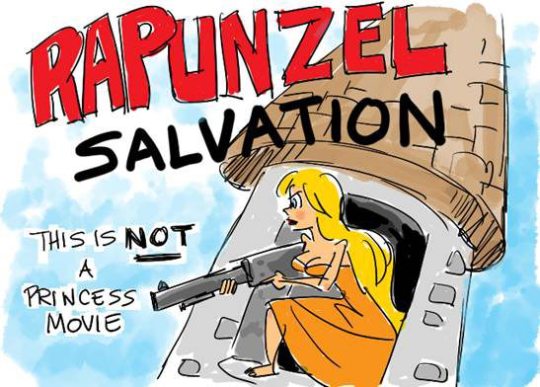
But what do I know? TANGLED came out in fall 2010 and was a very popular film. Right afterwards, THE SNOW QUEEN was put back into development, as was the JACK AND THE BEANSTALK movie. As you probably know, THE SNOW QUEEN became FROZEN, while the latter - titled GIGANTIC - lumbered through development hell and ultimately got canned by Lasseter. Disney would also proceed to remake several animated fairy tales in live-action, from CINDERELLA to BEAUTY AND THE BEAST to ALADDIN.

However, Disney Animation at least completed TANGLED. And released it. Saw it through, no matter what level of confidence that the higher management at The Walt Disney Company had in it. GIGANTIC wasn't anywhere near completion when it was scrapped, as the movie had been penciled in for a Thanksgiving 2020 release, and the movie was put on the shelf in fall 2017. A good three years prior.
That's when you DO cancel something, should you ever.
Not right near completion. Or even halfway there. Looking at you, former DreamWorks management, with LARRIKINS and B.O.O. and MONKEYS OF MUMBAI-yes indeedy I still haven't forgotten about that.
Anyways, if you're almost done, just fucking complete it. Maybe down the line, it won't be much of a loss. It might even be a surprise hit.
7 notes
·
View notes
Text
So. Seeing this script bit, I'm taken back to the post I made earlier about time loops.

Script Source: lifted from Nat's post
Recalling what I said about gates possibly opening a portal across space-time:

And the possibility of Henry doing something to his past self to try and change his own fate:

And how that might apply to the adults in filmed canon vs the young versions of the adults in TFS:

Then this bit of script actually fits perfectly with what I was saying.
This memory, this conversation, "past timeline", is well before 1983:

Thus, it would also technically be before the 1953 alteration.
That is to say: Things happened differently before 1983, up until 1983, and then around November 6th, 1983, 1953 was changed. Thus, anything that happened before 1983 would be a past timeline, because the 1953 alteration would, technically, have occurred after Nov. 6th, 1983.
The beginning of the time loop, even.

13 notes
·
View notes
Photo

TV Guide - November 30 - December 6, 1963
George Campbell Scott (October 18, 1927 – September 22, 1999) was an American actor, director, and producer who had a celebrated career on both stage and screen. With a gruff demeanor and commanding presence, Scott became known for his portrayal of stern, but complex, authority figures.
Scott was in much demand for guest shots on TV shows, appearing in episodes of Ben Casey and Naked City. In 1962, Scott appeared as school teacher Arthur Lilly on NBC's The Virginian, in the episode "The Brazen Bell", in which he recites Oscar Wilde's poem "The Ballad of Reading Gaol". That same year, he appeared in NBC's medical drama The Eleventh Hour, in the episode "I Don't Belong in a White-Painted House". He appeared opposite Laurence Olivier and Julie Harris in Graham Greene's The Power and the Glory in a 1961 television production.
In 1963 Scott starred in the hour-long television drama series East Side/West Side. He portrayed a New York City social worker, along with co-stars Cicely Tyson and Elizabeth Wilson. Scott was a major creative influence on the show, resulting in conflicts with James T. Aubrey, the head of CBS. The Emmy Award-winning program had a series of guest stars, including James Earl Jones. The portrayal of challenging urban issues made attracting advertisers difficult, not helped by the limited distribution. Not all CBS network affiliates broadcast the show, and it was canceled after one season.
During the early 1970s, Scott appeared in the made-for-television films Jane Eyre (1970) as Mr. Rochester and The Price (1971), a version of the Arthur Miller play. For the latter role, he won an Emmy Award, which he accepted. He also directed a TV version of The Andersonville Trial (1970).
Scott appeared in a television production of Beauty and the Beast (1976), with Trish Van Devere. In 1981 was cast as Fagin in the CBS made-for-TV adaptation of Charles Dickens' Oliver Twist (1982). He starred in China Rose (1983) on television, and in 1984 portrayed Ebenezer Scrooge in a television adaptation of A Christmas Carol. He was nominated for an Emmy Award for the role. Scott played the title role in the made-for-television-movie Mussolini: The Untold Story (1985).
Scott reprised his role as Patton in a made-for-television sequel, The Last Days of Patton (1986). Based on the final weeks of Patton's life after being mortally injured in a car accident, it contains flashbacks of Patton's life.
On television, Scott did The Murders in the Rue Morgue (1986) and Pals (1987; with Don Ameche). He also played the lead role in the TV series Mr. President (1987–88), which ran for 24 turbulent episodes. He was also on the Johnny Carson Show in March 1987. Scott starred in the television film The Ryan White Story (1989) as Charles Vaughan, the lawyer defending Ryan White. (Wikipedia)
8 notes
·
View notes
Note
leaf im trying of expand my horror film history knowledge and also just out of curiosity please i need to know your favorite vampire films. the campiest ones, the essentials. the so bad it's good ones. give me the juice
YIPPEEEEE okay so. i have made it my life goal to watch every movie on the vampire films wikipedia, im not yet there, but i will give you all the favorites of the ones ive watched so far
first off, LOST BOYS!!!!! (1987) my favorite movie of all time, i could watch it every day for forever, the style, the vibes, the soundtrack, everything is so perfect. amazing execution of a horror comedy, about familial love and the feelings of alienation in youth (so many queer undertones), this is a movie for fags
for essential films, i gotta say nosferatu (1922), dracula (1931), [also check out the spanish version of dracula (1931) if you can get a hold of it, it comes with the dracula dvd if you have it at your local library], horror of dracula (1958), blood and roses (1960), the vampire lovers (1970), and the blood splattered bride (1972). three early dracula adaptations, and three carmilla ones. these, esp the dracula ones, lay the groundwork for vampire movies.
for some comedy and camp, check out what we do in the shadows (2014), vamps (2012), love at first bite (1979), dracula:dead and loving it (1995) <-thats where the blood gif i reblogged is from, dracula ad 1972 (1972), buffy the vampire slayer (1992) <-i prefer the show but the movie has its charm, so bad its good, was a fun watch, and jesus christ vampire hunter (2001)
idk what to title these last ones but i love them, the hunger (1983) <- also if u can find a copy of the book it was an amazing read!!, interview with the vampire (1994) <- also check out the new show if u feel like it, its even better than the movie to me, blade (1998), let the right one in (2008), only lovers left alive (2013), and a girl walks home alone at night (2014)
i'll keep u updated as i watch more <3
also if u havent read the vampyre by dr polidori, carmilla by sheridan le fanu, or dracula by bram stoker id def recommend them, those are the big three in vampire lit history. also the vampire a new history by nick groom is a wonderful book about the history of the vampire myth
#okay that was a lot lol#i loooooooove vampires#anyway. yeah#let me know if any titles jump out at u and i can tell u more abt them if u want#i love u so so much thank u for asking about vampire movies <333
51 notes
·
View notes
Text
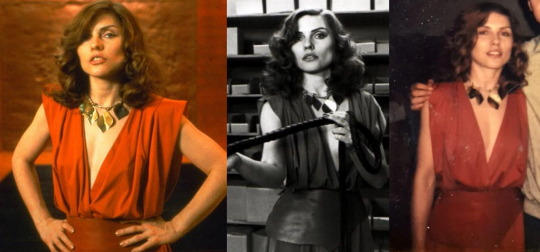


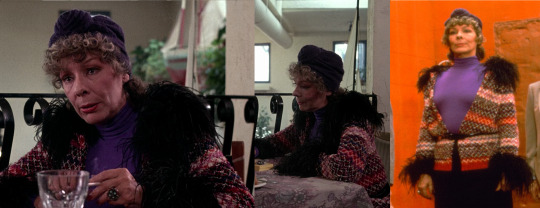



David Cronenberg isn't really one for flashiness in sets and costumes in his films; if there was a scale of auteurs ranked by flamboyance, he would be at the bottom - Ken Russell and Federico Fellini would be at the top.
Videodrome (1983) is a slight exception, as after all it's about tacky television. The film's costume designer was Delphine White. Debbie Harry as Nicki Brand gets to wear two bold-red outfits (cos get it, it's a sexually stimulating colour); the hallucination torture-room dress has a big leather belt and is the one she wears in all the promotional photos. It looks really cheap mind, so it was probably bespoke made? The red suit with epaulettes that she wears in the talkshow scene was most certainly bought though.
Lynne Gorman as Masha gets to wear two really nice, off-the-rack coats; a long leopard print coat, and a multicoloured shorter version with black trim that's only seen better thanks to a deleted scene.
There's actually a fair bit of dressing up for the film's various shows-within-a-show; a random belly dancer (presumably wardrobe stock) during the scene where Masha warns Max Renn off hunting for the 'videodrome' torture show, and mock renaissance/dancer outfits for the Spectacula Optical trade show performance. No idea if the renaissance fits are bespoke made or were bought from fancy dress shops, but the women's leotards have been altered (with the same materials as the men dancer's bowties) so that they form a glasses shape on their breasts!
#david cronenberg#delphine white#debbie harry#lynne gorman#james woods#videodrome#1983#horror#thriller#costume design#film fashion#Spectacular Optical
7 notes
·
View notes
Photo
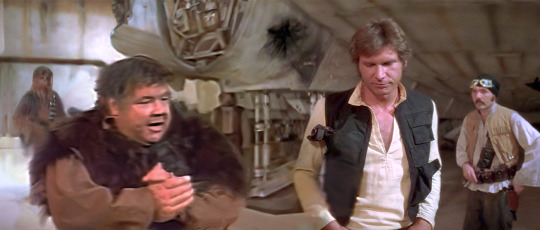
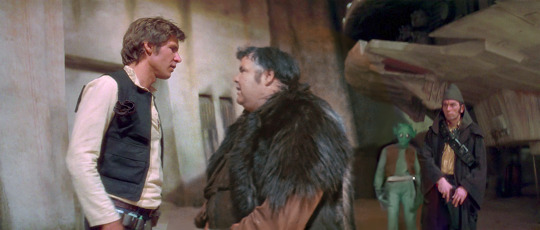

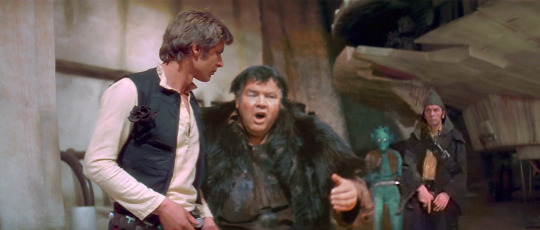
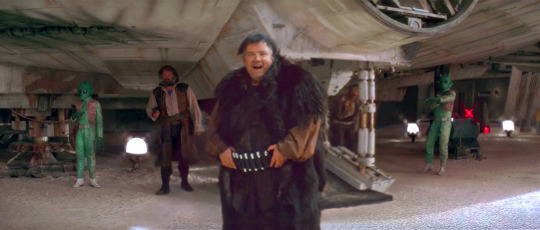
Star Wars Deleted Scene
Jabba The Hutt 1977 Declan Mulholland
HD restoration by Garrett Gilchrist.
https://archive.org/details/star-wars-deleted-scene-jabba-the-hutt-1977-declan-mulholland
This restoration took the better part of a month and involved digitally-painted animation keyframing in Photoshop throughout, at least once per second, with EBSynth and Rife generating a consistent appearance over the low quality sources.
Declan Mulholland played gangster Jabba the Hutt in a deleted scene from the original 1977 Star Wars. Some lines from this scene were used in Han's confrontation with Greedo. A clip of the first part of the scene appeared in 1983's "From Star Wars to Jedi."
For 1983's Return of the Jedi, Jabba the Hutt was redesigned as a large sluglike creature.
The 1981 Star Wars Radio Drama retcons this character to be a henchman of Jabba's nicknamed "Heater" (and the 70s comic adaptation uses a cantina alien, retconned to be Jabba's accountant Mosep Binneed).
In 1997, this scene was restored to the film with a CGI Jabba. Some clips were released when discussing the CGI work, although the scene has never been released in full.
The CGI version is edited slightly differently, with Jabba's shots being longer and Han and Chewie's shorter. Han is also often cut out from the background and missing parts around the edges. The scene was redone with a different CGI Jabba in 2004, with some changes made to the background as well.
star wars, deleted scene, deleted magic, a new hope, 1977, declan mulholland, harrison ford, han solo
50 notes
·
View notes
Photo

A diorama featuring the William Stout-designed version of Godzilla for the never made 1983 film Godzilla: King of the Monsters in 3D.
63 notes
·
View notes